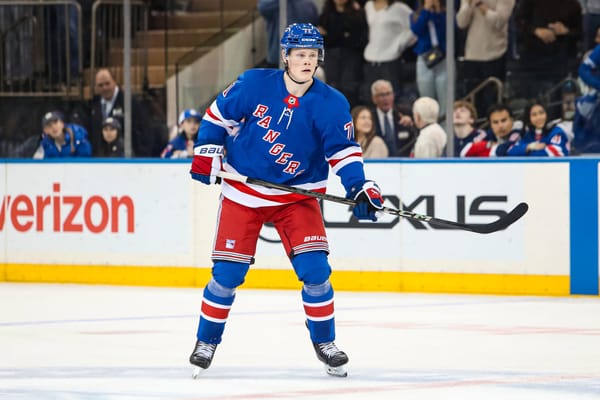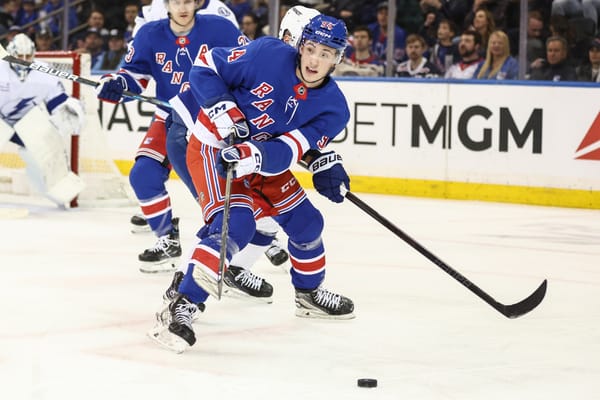2020 NHL Draft: Trade-up Targets and Potential Fallers for the Rangers
Identifying three intriguing prospects who could fall into the Rangers’ grasp with some luck or ambition.
Trading up in the first round of the draft is a concept that generates lots of chatter. The players higher up in the draft are more exciting than the ones available later in the draft. So what if we packaged multiple assets in order to obtain one really good prospect?
In practice, those types of moves rarely happen. It turns out that other teams share your observation about the top of the draft. They too think there are some very exciting players available earlier in the draft, and the reasons you want to trade up are the very reasons they’d prefer to stay where they are!
These swaps do happen, but movement on the draft board is often fairly underwhelming. At the 2019 draft, the it cost the Arizona Coyotes the 45th overall pick in order to move three spots from 14th overall to 11th. The year prior, the St. Louis Blues parted with the 76th overall pick in order to move up from 29th to 25th, while the Rangers themselves paid a very heavy price, parting with the 48th-overall pick in order to make a modest move up from 26th to 22nd.
Teams are often quite happy to stay where they are, and so the catch-22 is that the cost of trading up is often so high as to make it not worthwhile. Even if the Rangers want to, it will be all the more difficult without zero 2020 second-round picks in stock.
There are some factors which do a least add some plausibility to he equation for the Rangers. First, this is an unprecedented kind of offseason for a myriad of reasons. The timing is different. Team’s financial outlooks are different, and so the trade market looks different. That doesn’t mean the playbook is completely thrown out the window, but everyone is less confident in what they believe to be not possible.
The Rangers also have some players potentially up for grabs who could help them move up in the draft, if not outright obtain a first-round pick the teens. Pavel Buchnevich, Tony DeAngelo, and Ryan Strome are, to varying degrees, potentially in the mix. The Rangers have every intention of keeping Alexandar Georgiev, but there are multiple teams currently drafting in the mid-teens who could be looking to upgrade in goal. It’s not likely, if one of those teams was covetous enough to offer up one of those picks, I think the Rangers would be hard-pressed to turn it down.
Finally, the Rangers have a consider wealth of young talent, including top prospect pool in the league even before Lafreniere officially enters the mix. If the right player is available, they perhaps have the luxury to absorb a trade in which they “lose” on objective value for the sake of obtaining a player they feel they particularly could use.
Another possible, and in the case of certain players, more likely scenario, is the unexpected draft drop. At the 2018 Draft, Joe Veleno was viewed as a potential top-10 pick and safe bet in the top-15. He instead fell all the way to Detroit at 30th overall. In 2015, Matt Barzal infamously dropped out of the top-10 to the Islanders at 16th overall.
It happens every other year to varying degrees. Four teams happen to like one guy a little bit more. Another few reach for positional need. Two more did a poor job scouting. Suddenly, the draft is now onto 19th overall and a player who was expected to go in the 9-13 range is still available. Maybe he makes it to the Rangers at 22nd, or maybe it’s at that point the Rangers can more realistically strike a trade and move up a few slots.
Here are three players ostensibly out of the Rangers’ reach right now whom I believe the team would be targeting in a theoretical trade-up or who are darkhorses to fall within range of their 22nd-overall pick.
Anton Lundell
Before we start, let me say that on the off-chance the Rangers actually do end up with any of these players, we will publish more thorough scouting reports.
Lundell is a two-way center who has already excelled at the pro level. For HIFK Helsinki in Finland’s Liiga, he produced 10 goals and 18 assists over 48 regular season games. Over the past 20 seasons, he ranks sixth among all first-time draft eligible players in Liiga by points-per-game, ranking above some notable NHLers such as Jesperi Kotkaniemi, Sebastian Aho, and Roope Hintz.
And yet Lundell’s value largely lies in his defensive prowess. He defends with intuition beyond his years. Only Jesse Puljujarvi had a higher shot attempts percentage at five-on-five last season. Helsinki leaned heavily on him for defensive situations and he won nearly 60 percent of his defensive-zone draws.
The concern about Lundell is his offensive upside. Yes, he has produced decent enough numbers in Liiga, but he lacks any standout abilities. He’s not going to be a major point producer at the NHL level and any decent team won’t feature him on its top power play unit. Furthermore, he is one of the oldest players in his draft year, turning 19 on October 3rd.
If this description is a put-off on the basis that it sounds a lot like Lias Andersson when the Rangers drafted him, then yes. The connection is pretty easy to make. Without making any definitive statements on Andersson’s future in the NHL, Lundell’s offensive game maybe does offer a few assuring differences. For one, while his skating is unremarkable, it’s not actively a hindrance in his game. He can keep up with plays just fine and has enough jump in his step to at least maintain any initial separation. Secondly, he’s a better driver of possession. He’s more comfortable carrying the puck and taking on defenders, and his vision is superior. Andersson is shoot-first, whereas Lundell is more of a playmaker.
I wouldn’t personally go as far as to say Lundell lacks first-line upside, but I think that’s absolute best-case scenario. More realistically, he turns into a second-line or middle-six pivot. While he could very well go in the top-10, as projected at the start of the season, that lack of perceived upside has already hurt his stock.
The chances of Lundell dropping anywhere close to the Rangers at 22nd overall is virtually zero, but he could certainly drop into the mid-teens. The Rangers’ need at center is well documented by this point, and with so many other high-upside players in the fold already, Lundell sticks out like a sore thumb as a possible option to add stability to the position.
Seth Jarvis
In a series of skills competition events, Seth Jarvis would likely not stand out in any single moment. The diminutive forward lacks standout qualities of any kind. Nobody would assign him any superlatives for his, skating, shooting ability, or puckhandling. And yet he finished the 2019-20 WHL season with an eye-popping 42 goals and 56 assists in 58 games; good for second in the WHL in points.
Jarvis simply has a lot of B-level qualities, with the result being greater than the sum of his apparent parts. Yes, he is (generously) listed at 5’10, but his core and leg strength compensate for that size. He’s a hawk on the puck, and I’ve seen him withstand physical pressure and win more battles for 50/50s than just about anyone. He has enough speed and skill to create his own offense both off the rush and in controlled possession plays. While he’s not necessarily a shooter who will beat goalies clean from distance, his hands are so quick that he can pick corners from the slot with ease. He’s a menace on the forecheck and, with his speed and work ethic, is actually a very capable penalty killer. I’d argue he’s one of the best defensive wingers in the draft. In a lot of ways he reminds me of Flyers’ rookie Joel Farabee.
On statistics alone, Jarvis would be a strong contender to go in the top-10 or, at worst, just afterward. And he very well may. It is also easy to see how, right or wrong, he is a candidate to drop in the draft. The days of size singlehandedly dropping potential superstars like Johnny Gaudreau and Theo Fleury into the late rounds of the draft are, for the most part, long gone. Still, the stigma against smaller players hasn’t completely disappeared.
There may also be anchoring bias involved. Last summer, nobody had Jarvis as a first-round talent for 2020. By midseason, his reputation had grown, although he was still largely viewed as a late-first-round talent. His play took off in the second-half of the season, and while some scouts will admire his tremendous growth, some may be nervous about using a high draft pick on him when there are other players available whom they may view as more reliable based on performance over the last two seasons.
TSN Bob McKenzie’s draft list, which is based on rankings he received from actual NHL scouts, puts Jarvis 18th. His coworker, and former NHL scout, Craig Button, ranked Jarvis 23rd.
Do the Rangers need a right-winger? In fact, that’s just about the team’s last priority. But talent is talent, and Jarvis would be a hell of a catch anywhere near 22nd overall.
Yaroslav Askarov
The Russian goaltender has been called the best one in any draft since Andrei Vasilevskiy in 2012 by some, or Carey Price in 2005 by others. I think that massively undersells Spencer Knight in 2019, but that’s not really the point. The hype for Askarov is massive. He was a star at the 2019 U18 World Championship, then absolutely dominated the 2019 Hlinka/Gretzky Tournament. It’s only going to help his cause that, at only 18 years old, he’s playing his way into the starting job for SKA St. Petersberg; maybe the best team in the world outside the NHL.
Askarov is a strong contender to get drafted in the top-10. In fact, Sportsnet’s Jeff Marek reported that the Ottawa Senators are considering him at fifth overall. All it takes is for one team to rate him high enough and the speculation can end as soon as it begins. Historically, though, projecting the landing spots for goaltenders is a finicky exercise. Developing young goaltenders is a labor of love. Many teams are behind the curve in terms of evaluating and developing them, and so some may avoid Askarov out of fear of not trusting their ability to make it work. Other teams simply may not perceive a need for goaltender. The Florida Panthers, having just drafted Knight 13th overall last year, likely would avoid Askarov with their 12th-overall pick this year.
The other issue many teams may face is the dreaded “Russian Factor.” The Rangers had to wait five years before Igor Shesterkin came over to North America. The Islanders only just recently signed Ilya Sorokin, whom they drafted in the third round in 2014. Askarov is his own man. Maybe he’d like to sign as soon as possible and ride busses in the AHL for a lesser salary than what he’d earn for Russia’s best team. Or, maybe it’s going to be a long wait before a team can begin to see returns on investment in him. Maybe, even, he does not like the team which drafts him altogether.
Do the Rangers need Askarov? Well, not desperately. They wouldn’t trade up to grab him, certainly. But if he fell to the Rangers then his value at that spot makes him potentially worth it. The Rangers are confident in Shesterkin’s future and would have no problems letting Askarov marinate in Russia for four or five seasons if need be.




